Joanna Slominski ’04 wants us to think differently about construction — it’s more than bricks and concrete.
Read More


In an exercise with a third-year housing studio, Kathleen Lechleiter ’81, ’82, FAIA, asked her students to consider the concept of “home.” The students wrote poems about what home means to them, developed imagery and visuals of home, then moved on to create three-dimensional representations.
It was a prompt designed to inspire them to begin in the abstract. Before considering the measurements, materials, and building codes, a great architect understands the environment, the residents, the community — and how it feels to be home.
Kathleen embodies this as a practicing architect. Her passion for empowering communities and educating future generations of architects has brought a colleague and me to Baltimore, Maryland, to experience her approach.
We meet Kathleen at her architecture firm, Twopoint Studio, in the historic Fell’s Point neighborhood. After a 10-minute drive, we arrive in Johnston Square, an east Baltimore neighborhood where row homes make up most of the housing, and park on a residential street. Row homes — narrow, multi-story homes built in a continuous line along a street — are, as Kathleen tells me, “quintessential Baltimore.” (Twopoint itself is housed in a renovated row home-turned-office.)
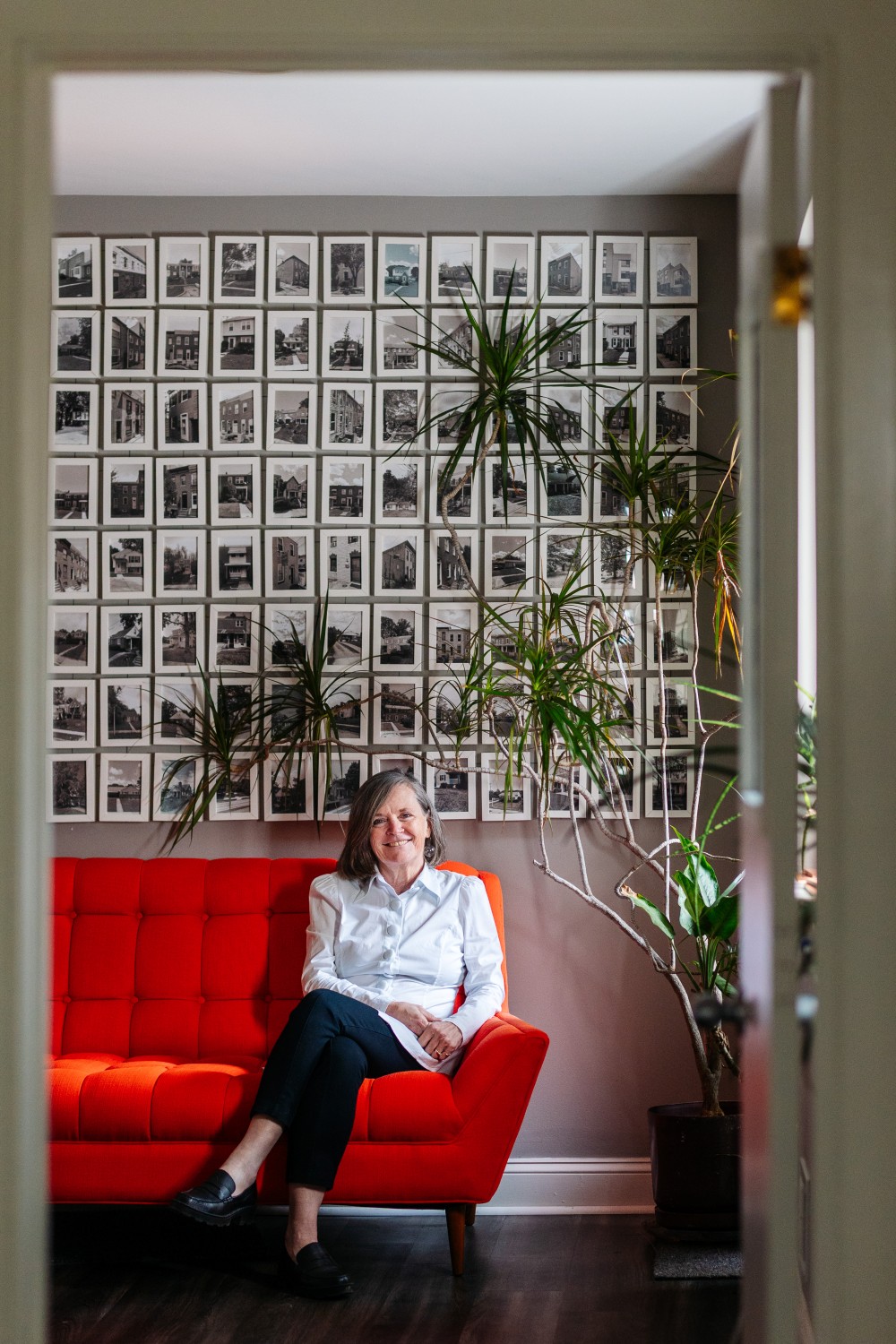
ReBUILD Metro, a Baltimore developer committed to revitalizing homes without displacing residents, has hired Twopoint to redesign and revitalize 36 properties across two projects in the neighborhood. After construction is complete, the units will be incorporated back into the community as low-income housing, rentals, and transition properties. Today, Kathleen, my colleague, and I, along with Baltimore-based photographer Breanna Pretz, are touring a few of the neglected and abandoned row homes ready for renovation.
“[ReBUILD Metro’s] focus is on creating stable communities, and they do this house by house, block by block,” Kathleen explains.
Kathleen points out exterior features of the homes. The cornices — some ornate, some simple — are the builders’ “calling cards.” The facades vary, she explains; many feature the original brick, while others have been painted. Some are clad in a locally controversial faux rock called formstone that exploded in popularity in the mid-20th century.
Row homes are a quintessential fixture of Baltimore architecture. Half of the city’s 251,000 occupied housing units are categorized as attached single-family dwellings (Baltimore Magazine). Iconic features of row homes include brick exteriors, formstone facades (an artificial rock popularized in the mid-20th century), and white marble steps.

She draws our attention down. The steps in front of many homes are red brick or gray concrete. But punctuated down the block some feature a traditional material, now a source of local pride: white marble.
Kathleen climbs the steps, finds a combination in her notebook, and unhooks a padlock. The piece of plywood serving as a front door swings open in the wind. The floors creak as we venture through abandoned rooms. The brick fireplace has been dismantled.
“Isn’t it cool? I mean, I think it’s cool,” she laughs as we step over wood, glass, and garbage, delighted at the details, the historic charm, and the possibility of a fresh start.
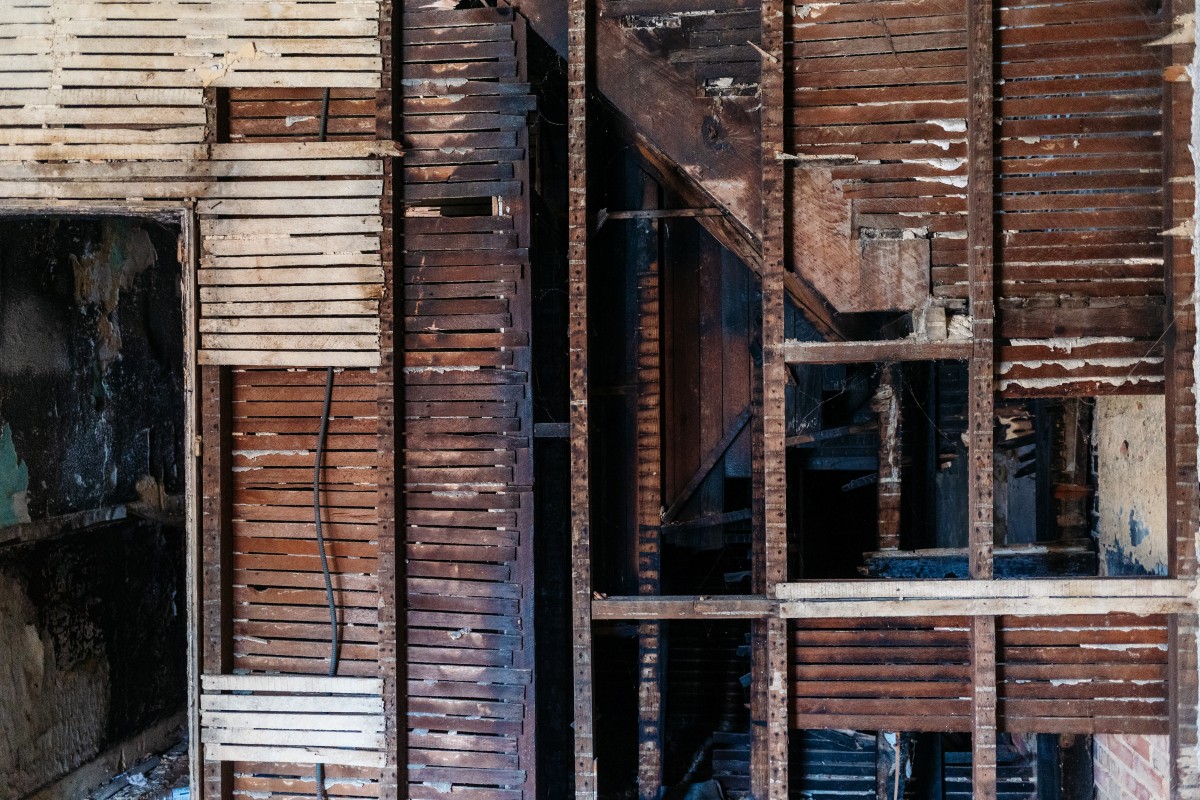
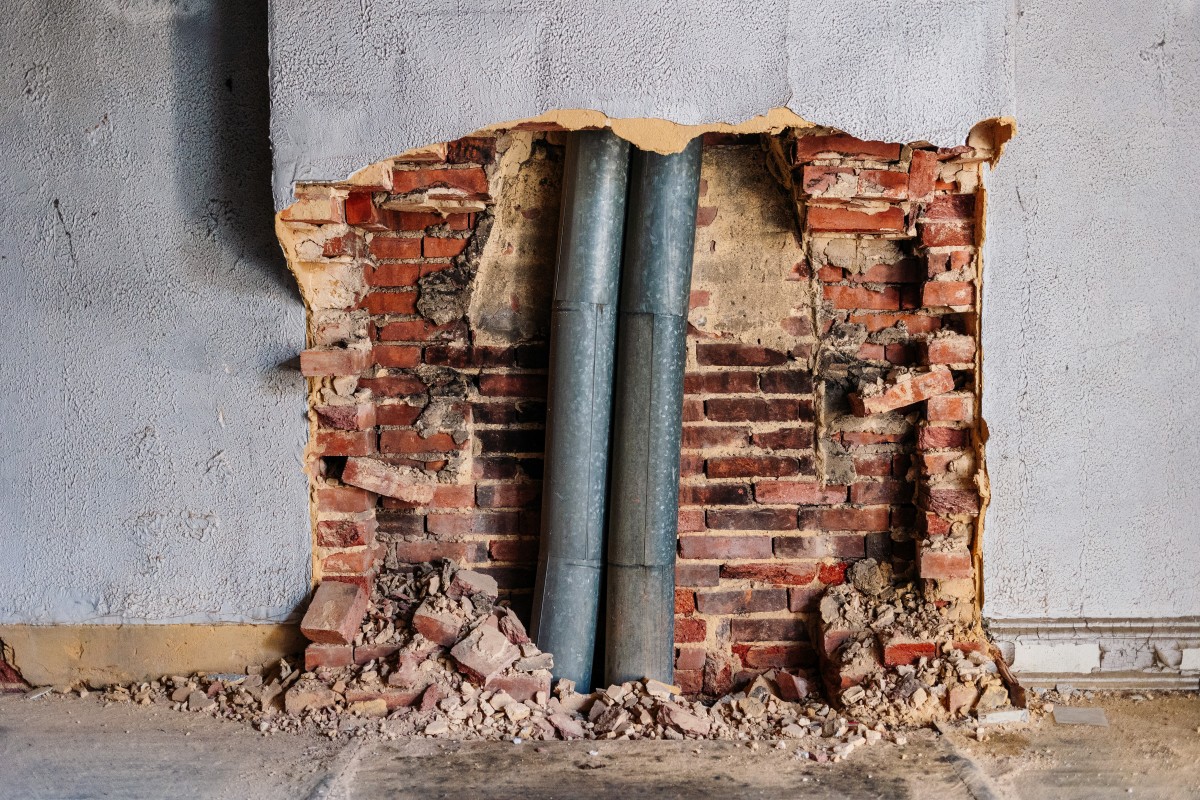
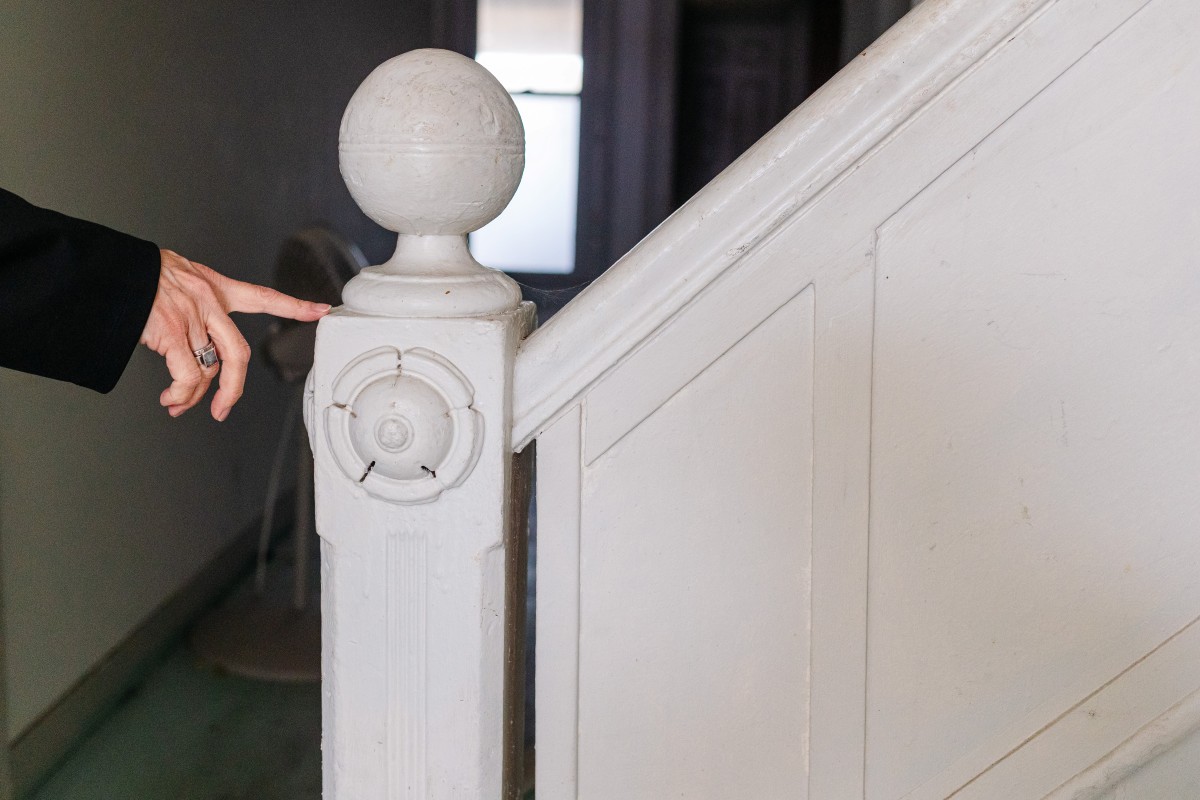
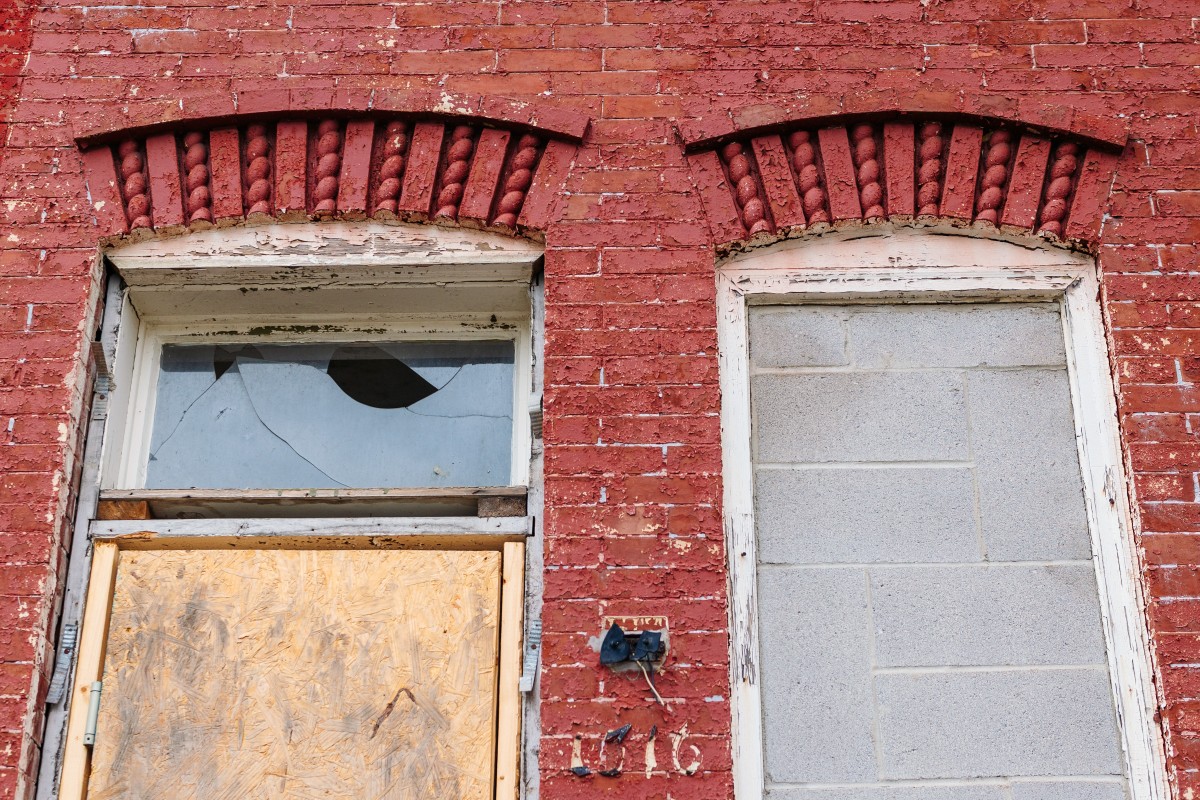
Row homes in the Johnston Square neighborhood date back as early as 1900. Twopoint Studio and ReBUILD Metro are renovating these historic spaces for today’s families and lifestyles.
In approaching projects like these, Kathleen and her team at Twopoint work closely with the developer to design the spaces to best suit residents. The firm partners with various city, state, and occasionally federal agencies to qualify for construction, program, and energy funding. Added collaboration with structural, mechanical, electrical, and civil engineers; historic and sustainability consultants; and landscape architects comprise a project team enabled to meet resident and city needs now and into the future.
“[Twopoint’s] overall practice focuses on healthy and just environments which include safe, stable, and dignified housing,” Kathleen said. “Enter the need to restore, rebuild, and reinvest in these homes and neighborhoods.”
Housing is a passion area for Kathleen; she explains that it is the “greenest” type of construction in terms of carbon footprint, and a need exists for the work — housing vacancy is a particular area of concern in Baltimore due to population decline. In October 2024, the Associated Press reported that more than 13,000 properties sat vacant throughout Baltimore. About two-thirds of Twopoint’s work is housing rehab.
“Something I try to stress to students is that we, as architects, are designing people’s homes. It’s where they celebrate birthdays and do their homework,” she said. “Just because someone might have fewer means, doesn’t mean that they don’t have a right to a place to call home.”
Kathleen leads us through another abandoned home using her iPhone flashlight, her black blazer collecting streaks of dust from the walls and banisters of homes dating back as early as 1900.
She explains how the double-hung windows provide air circulation to cool the structures, and that she will design around the original staircase footprint, regardless of today’s code standards, to follow city historic preservation rules. Outside, in an empty lot, she points out that the property lines fall between the original 12-inch-thick shared walls, and that when a structure is demolished, additional supports need to be added on either side to hold the adjacent houses in place.
The Johnston Square scattered-site housing projects represent a common challenge in Baltimore: renovating old and historic structures to provide housing for today’s families and lifestyles. These specific projects fall under the umbrella of “affordable housing,” which encompasses numerous living situations, including rentals, for-sale properties, workforce housing, and low-income or permanent supportive housing.
Regardless of the home’s specific use, Kathleen incorporates design principles aimed at bettering the residents’ living environments, improving conditions for the community, and investing in the city’s future. She incorporates energy-efficient systems that reduce energy usage and utility bills for the residents — including high-efficiency HVAC units, LED lighting, low-flow plumbing fixtures, and other sustainable features. Toxins, including lead paint, are removed, and low-VOC paints and formaldehyde-free kitchen cabinets are integrated into designs. Hardwood floors are often refinished or luxury vinyl tile is installed to limit health problems related to asthma.
Architecture, though commonly misunderstood as simply designing a residential or commercial building, is a holistic practice. According to the American Institute of Architects (AIA), “Architects play a critical role in designing buildings and communities that use resources wisely, preserve essential ecosystems, promote equity and access, and adapt to changing conditions” — a standard that Kathleen has met and exceeded in her decades-long career.
“My education at NDSU was instrumental in my approach to design and architecture,” Kathleen said. “We are problem solvers. We are inquisitive. We are seeking out methods to better our built environment. Aesthetically? Yes, but also sustainably, creatively, compassionately, and responsibly.”

As an adjunct faculty member and chair of the NDSU School of Design, Architecture, and Art Advisory Board, Kathleen collaborates with leadership in the NDSU College of Arts and Sciences. Together, they develop opportunities for students to receive hands-on experience during their undergraduate careers — ideally outside of the Fargo area.
In the fall semesters of 2023 and 2024, Kathleen hosted fourth-year NDSU architecture students in Baltimore. Students met with organizational collaborators, government representatives, and housing entities, plus toured active projects.
For Kathleen, it was exciting to take the fear out of the unknown for the students and express to them that architecture is “not just about buildings.”
“It was something always in the back of my mind,” she said. “Is there a way to bring students from a predominantly rural area to a more urban area so they can understand: What are some of the issues everybody has in common? What issues are different?”
That drive inspired her and her husband, fellow architect and NDSU alumnus Rolf Haarstad ’82, to establish the Lechleiter Haarstad Architectural Traveling Scholarship for NDSU architecture students, providing them the opportunity to deepen their understanding of how cultural and environmental factors shape the built environment.
Thanks to its well-rounded curriculum, mentorship opportunities, and experiential learning, both Kathleen and Dr. Susan Schaefer Kliman, FAIA, chair of the NDSU Department of Architecture and Interior Design, see NDSU as a leader in architecture programs across the country.
“We’re known throughout the region as a program that turns out graduates who are career ready. We combine the right amount of design theory with the practicality of everyday practice,” Susan said. “We have a responsibility to provide our students with the background and experience to understand how to engage with their communities.”
Throughout Johnston Square, Kathleen casually points out other homes she has designed throughout the past decade. She has become a partner in growth and a character in the history of this community, designing homes and empowering community members.
“Kathleen has devoted her career to bringing community-centered design to create new models for housing that remove the stigma of low-income, foster ownership for those who seek it, and eliminate housing insecurity for thousands facing harsh challenges in her own community of Baltimore,” Susan said. “She practices what she teaches, engaging directly with veterans, families experiencing homelessness, recovering addicts, refugees, and immigrants as well as connecting with businesses, non-profits, and community organizations to create practical, sustainable, and affordable housing.”
We make our way toward the final home of our tour. House after house on the block greets us with a plywood door and window covers painted blue — an indication that they are owned by ReBUILD Metro — each house number spray-painted in black. Vacant. Vacant. Vacant.
Where a set of stairs once stood, Kathleen reaches up to unhook another padlock, the crumbling formstone around the door revealing original red brick underneath. The makeshift door swings open. Where I expect to see a living room and the iconic long hallway, a surreal scene: exterior walls, a tree growing through the remains of a fireplace, and where a roof should be, a bright blue sky.
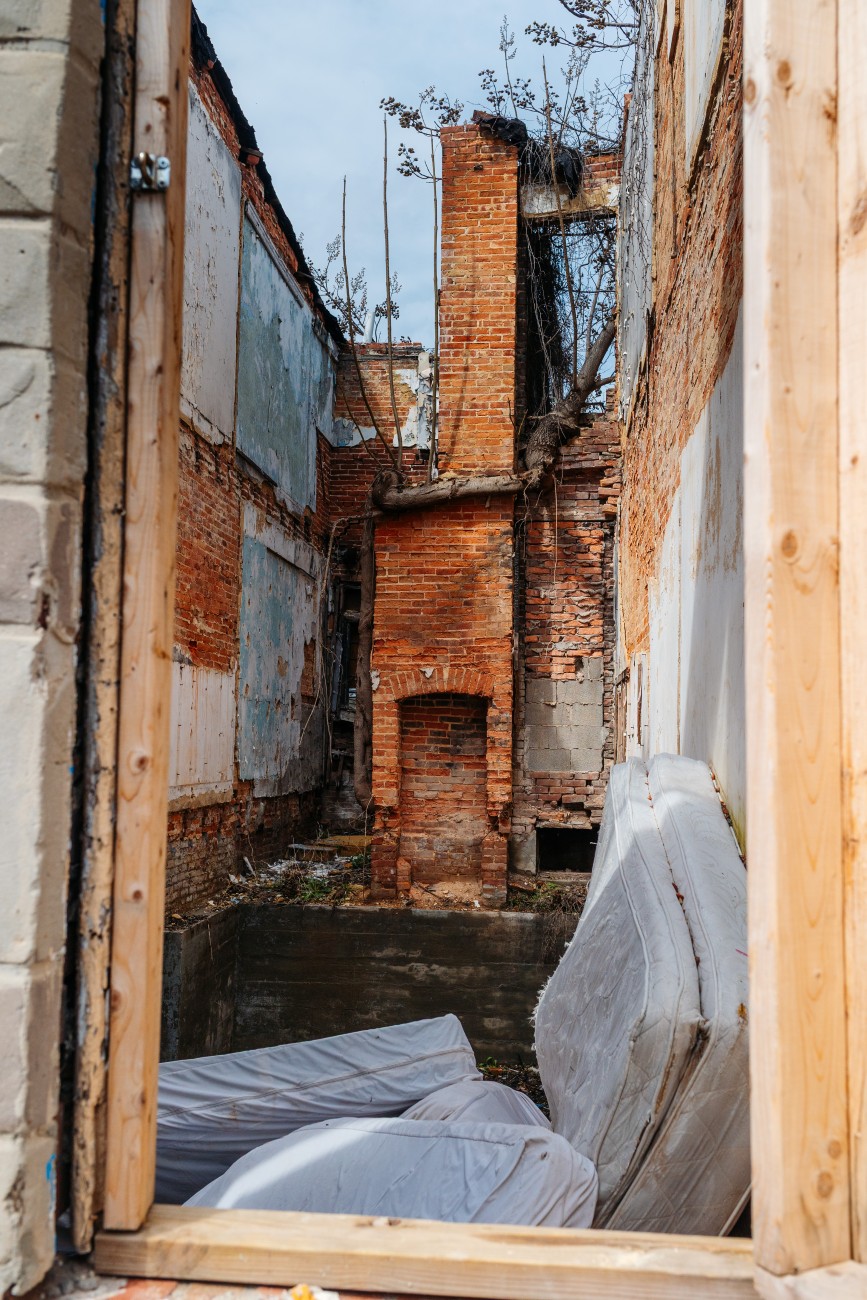
Kathleen explains that the aptly named “blue sky” row homes begin as vacant homes that deteriorate over years of neglect. Homes like this one have been cleaned out and are ready for development.
She points out the masonry pockets that once held the floor in place, and that a tree growing through a structure like this happens faster than you’d think — only a few years. Behind us, we hear a voice:
“You getting ready to fix that?”
Two older women are out for a walk, pushing strollers.
“Yes, we are,” Kathleen smiles and introduces herself.
“Well, I’ll be glad,” the neighbor says kindly, after joking and laughing with Kathleen. “We’ve waited.”
She points out her own home — she has lived on this street for more than 40 years.
“Hopefully we’ll have some new neighbors, some nice neighbors.”
Between kickoff meetings, building permits, and construction, this project will take at least a couple of years, but Kathleen is in it for the long haul, for the neighbors, and for the community.
Joanna Slominski ’04 wants us to think differently about construction — it’s more than bricks and concrete.
Read MoreHis middle school principal said he wasn’t cut out for high school, but Joseph Stanislao found a way to achieve the impossible...
Read More